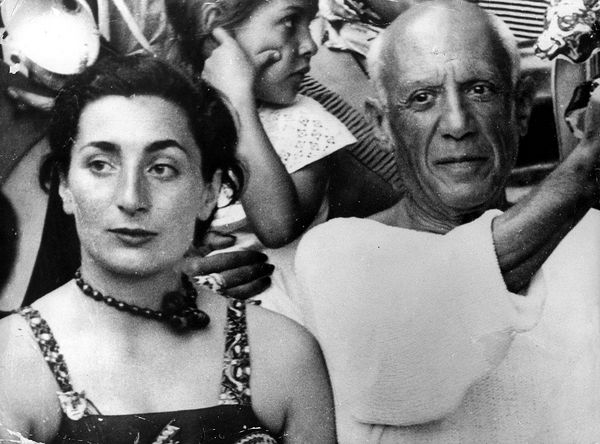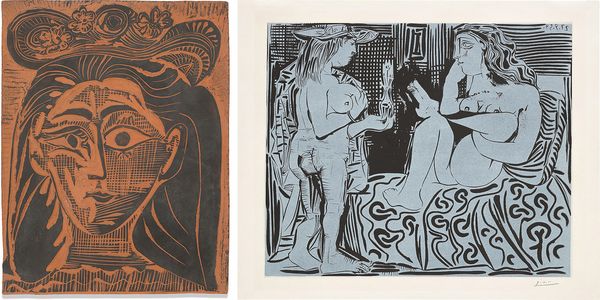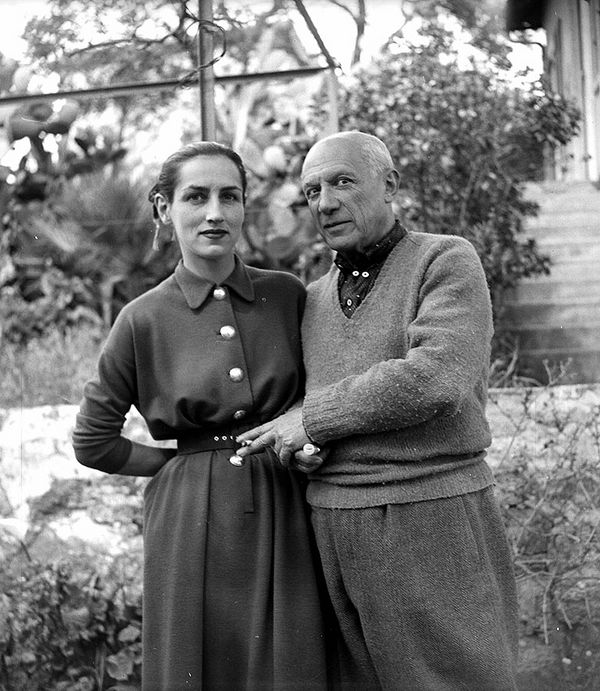Pablo Picasso and Francoise Gilot, 1952. Image: Roger Viollet via Getty Images.
Pablo Picasso produced his first print in 1899 while still a teenager, and his last in 1972 at the age of ninety. Remembered as a prolific painter, the abundant nature of Picasso’s creative output also stretched to his printed oeuvre: he produced more than 2,400 prints in a career that spanned over seven decades. Like many artists, Picasso was inspired by those around him and, over the years, the faces that meant most to him frequently appeared in his art. This was particularly true regarding the women in his life. The artist once said that “painting is just another way of keeping a diary,” a statement that could also be applied to his printmaking. Picasso’s prints feature the likenesses of many of his wives and lovers, documenting his tumultuous infatuations while also demonstrating his draftsmanship in a variety of printing techniques. The upcoming Evening & Day Editions auction at Phillips London includes a selection of Picasso’s most important editions in a variety of media, all of which include portraits of some of his most important muses — Marie-Thérèse Walter, Françoise Gilot, and Jacqueline Roque.
Etchings, Sugar-lift Aquatint, and Marie-Thérèse Walter

Left: Flip book photographs of Marie-Thérèse Walter, 1930. Right: Pablo Picasso, Quatre femmes nues et tête sculptée (Four Nude Women and a Carved Head), plate 82 from La Suite Vollard, 1934. Editions London.
Between 1930 and 1937, Picasso embarked on a series of one hundred etchings titled La Suite Vollard. The project was commissioned by its namesake, Ambroise Vollard, one of the most influential art dealers in Europe at the time. The etchings of La Suite Vollard function almost as individual diary entries covering this seminal period of Picasso’s life and career. Illustrating a wide variety of motifs that frequent the artist’s wider oeuvre, La Suite Vollard also documents the artist’s desire for his mistress and muse at the time, Marie-Thérèse Walter. Although still married to his wife of nine years, the Russian ballerina Olga Khokhlova, Picasso became romantically involved with Marie-Thérèse — who was twenty-eight years his junior — in 1927. The production of La Suite Vollard stretched over the entirety of Picasso’s affair with Marie-Thérèse, and she subsequently appears in many of the individual etchings.
Upon first meeting the seventeen-year-old Marie-Thérèse, Picasso was allegedly struck by her Grecian profile and reportedly said, “Mademoiselle, you have an interesting face. I would like to do a portrait of you. I feel we are going to do great things together...I am Picasso.” Picasso’s obsession with the young woman’s profile is evident through the artist’s many depictions of Marie-Thérèse, whose strong classical nose is frequently exaggerated in his artworks. In Quatre femmes nues et tête sculptée (Four Nude Women and a Carved Head), although unnamed, Marie-Thérèse is clearly depicted in the center left. In earlier plates from La Suite Vollard, the likeness of Marie-Thérèse features as a model for a bearded sculptor, with the latter character serving as one of Picasso’s alter egos. In this etching, plate eighty-two, she is depicted gazing up at the bearded sculptor who is in this instance represented as a bust. Throughout La Suite Vollard, Picasso uses the relationship between the bearded sculptor and Marie-Thérèse to consistently suggest an analogy between making art and making love. Similarly, the dedication and care required to create this incredibly detailed etching — and La Suite Vollard in its entirety — serves as an analogy for Picasso’s infatuation with his muse.

Pablo Picasso, Minotaure aveugle guidé par Marie-Thérèse au pigeon dans une nuit étoilée (Blind Minotaur Guided Through a Starry Night by Marie-Thérèse with a Dove), plate 97 from La Suite Vollard, 1934. Editions London.
Among the most famous images from La Suite Vollard is the ninety-seventh plate, Minotaure aveugle guidé par Marie-Thérèse au pigeon dans une nuit étoilée (Blind Minotaur Guided Through a Starry Night by Marie-Thérèse with a Dove). The artist focuses on the iconic profile of Marie-Thérèse — here depicted holding a dove — but also introduces another key element from his personal mythology: the Minotaur. For Picasso, the Minotaur was a myriad of symbolic meanings. On one hand, his contemporary Surrealists understood the beast to symbolize man’s violent, irrational and lustful desires. On the other, Picasso associated the creature with the bull, which he viewed not only as symbolic of his native Spain, but almost as a personal spirit animal. This print provides an insight into Picasso’s relationship with Marie-Thérèse, who is depicted as a guiding light and a symbol of peace to the blinded Minotaur, representing the artist. Demonstrating Picasso’s initial infatuation with Marie-Thérèse, he impotently follows her. Yet, the Minotaur’s reared head and distressed expression also infuse the image with a sense of anxiety, perhaps alluding to their tumultuous relationship which, by 1934, was already in demise.
With sugar-lift aquatint everything is more direct and at the same time more delicate.
—Pablo Picasso
Aside from documenting his complex and often turbulent affair with Marie-Thérèse, Minotaure aveugle guidé par Marie-Thérèse au pigeon dans une nuit étoilée also serves as an exquisite example of Picasso’s mastery of a printing technique known as sugar-lift aquatint. Under the guidance of the master printer of La Suite Vollard, Roger Lacourière, Picasso experimented with this new medium to create superbly tonal, painterly effects and rich textures. Through this combination of sugar-lift aquatint, drypoint, and engraving, Picasso produced one of the greatest graphic images in twentieth-century art.
Lithography and Françoise Gilot

Left: Pablo Picasso and Francoise Gilot, 1952. Image: Roger Viollet via Getty Images. Right: Pablo Picasso, Femme au fauteuil No. 1 (d'après le rouge) (Woman in Armchair No. 1, from the red), 1948. Editions London.
Following the end of the Second World War and the liberation of Paris from Nazi control, Pablo Picasso turned his creative attention to the medium of lithography. His renewed interest in this printing technique coincided with a new love interest: the 21-year-old artist Françoise Gilot. The pair met in 1943, moved in together in 1946, and had two children over their decade-long partnership. In the immediate post-war years, Françoise represented a renaissance for Picasso, with her presence symbolizing the exciting promise of a new beginning in his life and art. Unsurprisingly then, when Picasso embarked on a spate of over 400 lithographs in the studio of the printer Fernand Mourlot, it was Françoise Gilot’s likeness that frequently appeared in the images he produced.
Among the most famous lithographs Picasso created during this period were a series of prints titled Femme au fauteuil (Woman in Armchair). The series was originally intended to be a single, highly intricate five-color lithograph. Subsequently, zinc plates were prepared for each color the artist wished to work with: yellow, red, green, purple, and black. The initial idea for the project was abandoned due to sheer complexity, but Picasso continued to work on the now surplus zinc plates in a bid to create something new. Relishing the freedom lithography afforded him to easily rework an image in the same way he would a painting, Picasso amended the plates, producing several states from each. From the red plate, Picasso produced Femme au fauteuil No. 1 (d'après le rouge) (Woman in Armchair No. 1, from the red), creating four states overall, with the lot included in the upcoming Phillips Evening & Day Editions auction demonstrating the third state of the artist’s process. Widely considered to be the pinnacle of Picasso’s lithographic work, the Femme au fauteuil series highlights not only the artist’s mastery of the lithographic technique, it also exemplifies his sustained meditations on his lover at the time, Françoise Gilot.
Linocut, Ceramics, and Jacqueline Roque

Pablo Picasso and Jacqueline Roque, 1955. Image: Keystone Press / Alamy Stock Photo.
Following a move to the Côte d’Azur with Françoise Gilot in the late 1940s, Picasso had to alter his printmaking practice out of necessity, rather than desire. Far from the lithography and etching studios of Paris, Picasso lacked the specialist equipment required to work in such media. He also seemingly lacked the ability to be faithful to Françoise, who finally left the artist due to his serial infidelities in 1953. Salvation from his failing relationship and the geographical barriers to his artistic expression came in the form of a new medium and a new muse. A chance encounter led Picasso to the Madoura Pottery studio in Vallauris, owned by Suzanne and Georges Ramié. At Madoura, Picasso became enthralled with ceramics, and relocated to Vallauris to pursue his latest passion. It was also at the Madoura Pottery studio that Picasso met Jacqueline Roque, who was working temporarily in the studio’s adjoining shop. Picasso quickly became infatuated with Jaqueline and delivered a rose to her every day until she eventually agreed to be his companion. The pair were together for just over twenty years: they married in 1961, and their relationship lasted until Picasso’s death in 1973. Throughout this period, Picasso created over 400 portraits of his second wife, with Jacqueline becoming the most featured face within his oeuvre.
Love is the greatest refreshment in life.
—Pablo Picasso

Left: Pablo Picasso, Femme au chapeau fleuri (Woman with Flowery Hat), 1964. Editions London. Right: Pablo Picasso, Deux femmes avec un vase à fleurs (Two Women with a Vase of Flowers), 1959. Editions London.
Picasso’s blossoming relationship with Jacqueline not only coincided with his newfound love for ceramics — which resulted in Jacqueline’s likeness gracing the front of an earthenware plaque in Femme au chapeau fleuri (Woman with Flowery Hat) — but also through his innovative experimentations with linocut. Searching for a way to work on paper from his new location on the Côte d’Azur, Picasso met a local printer called Hidalgo Arnéra, who specialized in posters. Arnéra introduced Picasso to the linocut process and, over the following years, Arnéra assisted the aging artist in printing his works. They settled into a routine, with the artist working late into the night, and delivering the works to Arnéra’s workshop the following morning, often including annotations made by Jacqueline Roque. Arnéra would then pull proofs of the prints and return to Picasso’s residence at 1:30pm to review the fruits of their labor.
Fascinated by the immediacy of the linocut — the ability to carve a sheet of linoleum and have a print soon after — Picasso continued to experiment. He manipulated traditional making methods to invent a new ‘reduction’ linocut technique. Instead of carving a block for each color of a design, Picasso used one block for the total print, carving and reducing aspects of the image out of the same block for each color that was printed. He started with the lightest colors and finished with the darkest, giving each print more depth, texture, and fluidity. Produced in 1959, Deux femmes avec un vase à fleurs (Two Women with a Vase of Flowers) showcases the merits of Picasso’s innovative reduction technique, and superbly exemplifies the graphic quality and bold patterning characteristic of the method.

Pablo Picasso, Jacqueline au bandeau de face (Jacqueline with Headband), 1962. Editions London.
Picasso’s refinement of the linocut process culminated in a spectacular image of Jacqueline. Worthy of his final muse, the 1962 linocut Jacqueline au bandeau de face (Jacqueline with Headband), demonstrates the artist’s mastery of his innovative printing technique. Produced using brown, black and cream inks, the subtle nuances in color reveal the elaborate layering required to create the final print. Picasso’s dedication to the reduction technique is only overshadowed by his devotion to capturing Jacqueline’s beauty. Depicting her dark, shoulder length hair, striking almond eyes and straight nose, Picasso’s sheer adoration of his muse inspired him to simultaneously combine her profile with an en face view, exhibiting his ongoing Cubist interest in multiple perspectives but, above all, demonstrating his desire to capture every part of his second wife’s face.
The varied selection of exquisite prints by Pablo Picasso included in the upcoming Evening & Day Editions auction at Phillips London, exemplifies the Spanish artist’s mastery of multiple media and his prolific production of portraits of his wives and lovers. In many instances, Picasso’s bursts of interest in specific printmaking techniques coincided with changes in his relationships and personal life, demonstrating how his printed oeuvre can be viewed almost like a diary, representing significant biographical milestones and documenting his various infatuations. Spanning over forty years, four distinct creative methods, and three muses, this expansive selection of prints offers a broad overview of Picasso’s career in edition making.
Auction /
18 – 19 January
30 Berkeley Square, London, United Kingdom, W1J 6EX (map)
Viewing /
11 – 18 January
Monday-Saturday 10:00am – 6:00pm GMT
Sunday 12:00pm – 6:00pm GMT
Discover More from Editions London >
Recommended Reading
Devoted to Dachshunds: Artists and their Pets >
Joan Miró: From Venice to London >
Eternity in the Present: Whitehot’s Noah Becker on Alex Katz >
